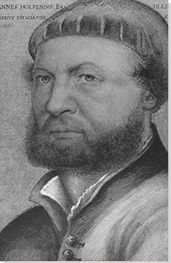Summary of Hans Holbein the Younger
One of the greatest portraitists of the sixteenth century, Holbein painted the English ruling elite, producing images that came to define their public personas, both in their own time and in later centuries. Beyond portraiture, Holbein was also a very versatile artist who turned his hand to religious paintings, frescoes, jewelry and clothing design, and book illustrations throughout his lifetime. Predominantly linked to the Northern Renaissance, Holbein also incorporated elements and ideas from the Italian Renaissance into his work to create sumptuous and detailed images with their own unique appearance. Holbein is particularly well known for his mastery of light and texture, and his exquisite portrayals of fabric, fur, and glass are a testament to his skill.
Accomplishments
- Holbein's art is considered realist in that he represented people with detail and precision, and was renowned for creating a true likeness (albeit, perhaps, a flattering one) of his sitters. His portraits are characterized by strong gazes, a diversity of appearance and carefully rendered clothing and accessories. Despite the meticulous nature of his portrayals, however, the images are often inscrutable, revealing little of the character of the sitter.
- Many of Holbein's portraits are rich in background details, often consisting of trompe l'oeil objects such as letters, flowers, and tools and these are believed to be symbolic. With some of the meanings now lost, however, their intended messages have become an area for modern art historical debate.
- Holbein's most famous images are those he painted of the English royal court and particularly of Henry VIII. These were created and utilized as propaganda to convey authority, masculinity, wealth, succession, and the divine right of royalty to rule to a wider audience. This was particularly important in a period of religious turmoil such as the Reformation.
The Life of Hans Holbein the Younger
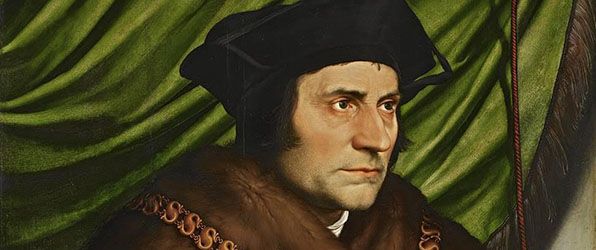
Despite his works being half a millennium old, Holbein’s depictions influence portrait artists to this day.
Important Art by Hans Holbein the Younger

The Body of the Dead Christ in the Tomb
In this panel, Holbein has created a life-size image of Christ, lying in his tomb. The greenish hue to the skin, in particular around the wounds on the hand, feet and torso, as well as on his face suggest the putrefaction of flesh and results in an almost grotesque image. Rather than creating a sense of calm or peace, the mouth and eyes are shown wide open, so that the pain endured on the cross seems to continue into the tomb. These elements emphasize Christ's humanity over his divine status and this is compounded by the unnaturally stretched and emaciated body being confined in an uncomfortably narrow space, imbuing it with an uneasy claustrophobia.
The recess in which Christ is laid is painted with an incredible sense of depth and this adds to the realism of the piece. This is further enhanced by the loose strands of Christ's hair which have fallen over the edge of the surface upon which he lies and his finger which also reaches over the edge and into the viewer's plane, reinforcing the dimensionality of the space. This is an early example of Holbein's use of trompe l'oeil, a technique that he would later apply to great effect in many of his portraits.
It is possible that the panel was intended as part of a Holy Tomb, in place of a sculpture or perhaps as a lid over a sepulchre. Above the body, angels hold instruments of the Passion and a Latin inscription reads 'Jesus of Nazareth, King of the Jews.' Art Historian Oskar Bsatschhmann notes that "Holbein transformed the image of the Christ at rest into the dreadful vision of a corpse, that of a man who had been condemned to death. Only the specific character of the wounds betray the identity of Christ." Although a fascination with the macabre was a common trait of early Protestant artists, their minds steeped in the apocalyptic horrors of the Reformation, this is not the only way in which to view Holbein's gory interpretation. The rotting flesh can also be seen to stress the sheer miracle of the Resurrection, occurring even after the human body has decayed.
Oil and tempera on lime wood - Öffentliche Kunstsammlung, Basel, Switzerland
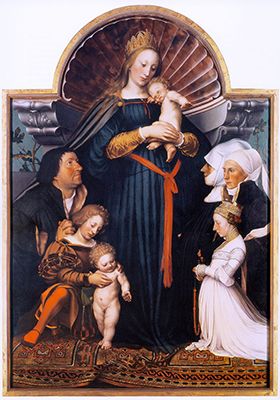
Darmstadt Madonna
This Schutzmantelbid, or 'Virgin of Pity' painting, is also known as the Madonna of Jakob Meyer zum Hasen, shows Jakob Meyer, a Basel official, having invoked divine protection for himself and his family. He is portrayed to the left, his eyes looking upwards to heaven. Opposite him are his two wives, his first wife, Magdalena Baer, who died in 1511 is positioned behind in profile, and in front, is his second wife, Dorothea Kannengiesse, in three-quarter view. Before them kneels their only surviving child, Anna, but to the left, in front of Meyer, are thought to be his two deceased sons. Above them all towers the Madonna, cradling the infant Christ. The buckled carpet upon which they stand demonstrates Holbein's skill in creating life-like texture and light, but also serves as a symbol of wealth and to draw the viewer into the pictorial space, so that they too are welcomed into the group, sharing the divinity bestowed by the Madonna and Christ child. This is one of Holbein's most famous religious works and art historian Helen Langdon attributes its success to "its depiction of individual human identities combined with spectacular spatial control and illusionism".
As with the depiction of Christ in his tomb, Holbein includes human elements, in the individual portraits of donor and family, but more particularly in the Madonna and child. The twisting of the infant's body serves to emphasise the physical weight carried in the arms of his mother. For the Madonna herself, her face is not a stereotypical rendition in the tradition of Italian Renaissance painters such as Raphael, but rather was painted from life and is based on model, Magdalena Offenburg. In this manner, the painting retains the softness of the Italian tradition (particularly in the rendition of the two boys) but also brings to bear the realism of the Northern Renaissance, as Langdon notes, "Holbein achieved a combination of piety and grandeur, and interaction between the human and divine, to rival that of Van Eyck himself." The resulting group portrait is much more than a simple devotional image and as Holbein's final major religious work, marked his future in portraiture.
Oil on panel - Private Collection
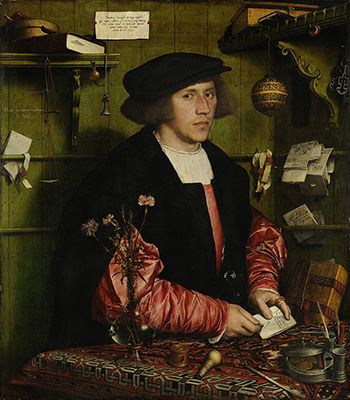
Portrait of Georg Giese
This portrait of wealthy merchant Georg Giese shows the trader in a three-quarter view, standing behind a carpet-covered counter, with various objects displayed across its surface. The sitter's name is on the wall to the left, along with his motto "no pleasure without regret". There are also letters on both walls that identify him and mark familial links to other merchant families, signalling a network of important connections. In these trompe l'oeil details, Holbein has gone as far as to recreate the writing of Giese's own hand on some of the correspondence. Amongst the many symbolic objects are carnations to signify an engagement or betrothal, a clock alluding to the passage of time, as well as a collection of tools to reinforce the profession of the sitter and a number of details indicating wealth. Giese's gaze is fixed towards the viewer and this allows him to dominate the space so that, even when surrounded by a busy collection of objects, the eye is still drawn to him. Holbein's artistic skill is particularly evident in the delicate glass vase and the sleeves of Giese's jacket, showing a Mannerist interest in surface texture. This realism later influenced 19th century advocates of naturalism in portraiture and this can be seen in the works of artists such as Bastien-Lepage, particularly in his Portrait of the Prince of Wales (1879-80).
This portrait marks the first major work by Holbein at the beginning of his second stay in London, prior to his royal appointment. It illustrates his development in portraiture and the influence of other artists of the Renaissance on him, most notably Titian. The pose and sideward glance being reminiscent of the Italian artist's Man with a Quilted Sleeve (1510). Simultaneously, the delicately painted vase with light reflecting off it was a typical feature of early Netherlandish paintings and this indicates a coalescence of influences in the artist's work, which shaped his style of portrait-making. The continued success of this portrait is illustrated in its use on the German 100,000 mark banknote in 1923.
Oil on oak - Gemäldegalerie, Berlin
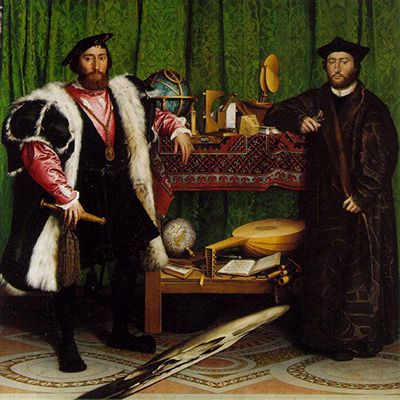
The Ambassadors
This double portrait depicts Jean de Dinteville, French ambassador to England, on the left and his friend Georges de Selve on the right. Selve was bishop of Lavaur and acted as ambassador to the Emperor, the Venetian Republic, and the Holy See. Their ages are revealed on Dinteville's dagger and the book upon which Selve is resting, as 29 and 25 respectively.
A range of objects fill the two shelves which separate the figures, including a celestial globe, a portable sundial and other instruments for measuring time or related to the study of heavenly bodies. These tell us something about the sitters, although some of the symbolic meanings have been lost over time. The terrestrial globe, for instance, has been customised so that in the center of the depiction Dinteville's chateau 'Polisy' is named, highlighting his identity and stature. In addition, a string on the lute is broken, a symbol of discord. This, in close proximity to Luther's translation of Veni Creator Spiritus, hints at spiritual guidance in resolving the religious and diplomatic tangles, which concerned these ambassadors.
The complex array of objects, however, remains ambiguous and presents more questions than clear answers. Overall it can be read as a portrait of the two diplomats, with allusions to the religious and political issues which preoccupied them, as well as the friendship between them. Holbein's finesse is not just evident the trompe l'oeil of these objects and the realism of the lustrous fabrics and fur trim, but also in his inclusion of an elliptical or anamorphic skull in the foreground, distorted unless viewed from a particular angle from the upper right or lower left of the painting.
Anamorphic imagery was popular during the 16th and 17th centuries, particularly in Baroque trompe l'oeil murals such as Andrea Pozzo's ceiling in the Church of St Ignazio in Rome (1690). It then fell out of favour in art until the 20th century, although the technique continued to be used in the fields of entertainment and popular culture. Modern examples can be seen the work of Dali such as Mae West Room (1974) as well as in large-scale public and land art installations. Michael Heizer, for instance, created Complex One (1972-74) in the Nevada Desert out of earth and concrete. When viewed from the correct angle it is visible as a rectangular perimeter that makes reference to the style and shape of Egyptian tombs. More recently, Felici Varini created Three Ellipses for Three Locks (2014) in Hasselt, Belguim, which is an image of three loops made up of sections painted on over 100 buildings in the city, it can only be seen in its entirety from a specific point.
Beyond demonstrating his skill, the skull also serves to remind the viewer of the Vanitas, the transience of human life and this contrasts with the crucifix, partially hidden in the top right hand corner of the image, a symbol of resurrection. As Art Historian Neil MacGregor asserts, the "picture conjures a floating, fallible world, in which the certainties are death and salvation and the enduring delight is friendship." It has been suggested that these two symbols in conjunction could operate as a reference to the immortalization of the sitters in paint, preserving a memory of them, even after death. If this was the intention, Holbein was more than successful and this is considered one of his most famous and enigmatic works, continuing to spark appreciation, discussion, and debate nearly 500 years later.
Oil on oak - The National Gallery, London
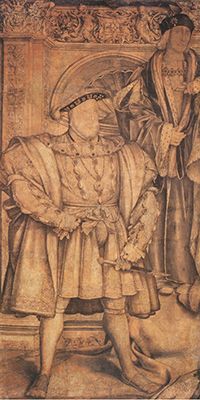
King Henry VIII
This preparatory full-sized cartoon is all that remains of a large group portrait created by Holbein which was destroyed in a fire at Whitehall Palace in 1698. This left portion of the final piece shows Henry VIII with his father, Henry VII. The missing right-hand section originally showed Henry's third wife, Jane Seymour and his mother, Elizabeth of York. In this drawing the king is presented in a strong, authoritative pose with his barrel-chested figure commanding attention. His presence is enhanced by his dress, including his padded jewel-encrusted jacket and a prominent codpiece, itself highlighted by a dagger which draws the eye towards it. Henry's physical proportions have been deliberately distorted to create a more imposing figure, with elongated legs for a slimmer and more athletic appearance. Behind him, his father looks considerably less sturdy in comparison, his almost over-sized robe, further diminishing his proportions. Henry VII had died almost 30 years earlier, and this is reflected in his gaze, which unlike his son, does not confront the view but rather looks into the distance, in thoughtful contemplation. Holbein elevates the grandeur of the piece with details of wealth and extravagance, such as the decorated frieze in the background and the buckled carpet upon which Henry stands.
The work is considered a propaganda piece and this is evidenced by the fact that the king was 46 years old at the time and suffered from physical ailments and ill-health, yet appears young and healthy in the image. This was a period of religious turmoil, with Henry VIII deposing the Pope as head of the Church of England in 1531 and assuming the position himself after the Pope refused to annul Henry's first marriage to Catherine of Aragon. This decision led to the dissolution of monasteries, convents, and friaries and the, often, violent seizing of their lands and property by the Crown. This chain of events resulted in a range of criticism, both in England and abroad and significant local resistance in some areas of the country. In this context it was vital to the King to be able to project both his divine right to make such decisions and also his unrivalled power, so that he was seen as unchallengeable. These elements are reinforced in Holbein's image through Henry's immense and powerful physicality and the inclusion of Henry's deceased parents in the group, cementing his claim to the throne. At this point, and despite three marriages, Henry had failed to produce a male heir, as such the portrait also conveys Henry's masculinity, notably through his sturdy build and the prominence of his codpiece, which is at eye height.
Holbein's portrait was so much to the king's liking that Henry VIII encouraged other artists to copy the painting, and gave these copies to friends and ambassadors. In addition to this, nobles had their own copies of the painting created to show their loyalty to the king. This explains how the image has become so iconic, despite the destruction of the original in the Whitehall Palace fire.
Ink and watercolour - National Portrait Gallery, London
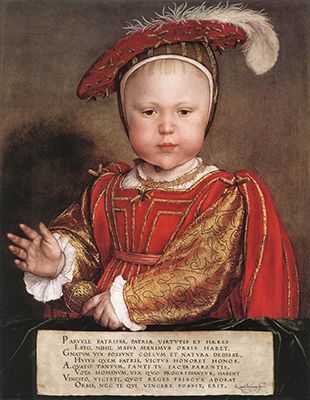
Portrait of Edward, Prince of Wales
This portrait of Henry's son Edward, is the earliest known likeness of the prince and the only painting of him by Holbein that has been preserved. It shows him at the age of two, although he looks considerably more mature, with Holbein instilling a kingly authority on the baby prince that is reminiscent of his father. He is regally attired in red and gold, wearing a tight cap called a coif, and feathered hat over the top, which is a miniature version of that worn by Henry in Holbein's earlier portraits of the king. In his left hand he holds a gold rattle, which evokes a royal sceptre. His royal appearance is further enhanced by the gesture of his right hand which is raised as if blessing the viewer, although this gesture is also reminiscent of images of the infant Christ, perhaps an allusion to the Crown's new religious role in post-reformation England. As such, Curator, Quentin Buvelot asserts that "the painting should be construed as an official portrait explicitly presenting the prince as the future king." This notion is reinforced by the Latin text at the base of the panel, which begins: "Little one, emulate thy father and be the heir of his virtue". The background, which has faded to a green-brown over time was originally a bright blue and its abstract appearance is countered by the shadow cast by the figure and the velvet covered balustrade behind which Edward stands, creating a real space for him to inhabit.
Although he painted many prospective brides whilst holding his position as court painter, Holbein only occasionally painted the king's family. Works such as this one, therefore, play an important part in informing our knowledge of the Tudor royal family, but such presentations must also be regarded with a critical eye. The image of Edward as a robust baby is in contrast to the prevailing view that he was frail and sickly. Langdon says that "this portrait is imbued with sad irony: this apparently healthy child would die of tuberculosis at sixteen." This illustrates the power of Holbein's images in creating and propagating a particularly narrative, often at odds with reality.
Oil on oak - The National Gallery of Art, Washington DC
Biography of Hans Holbein the Younger
Childhood
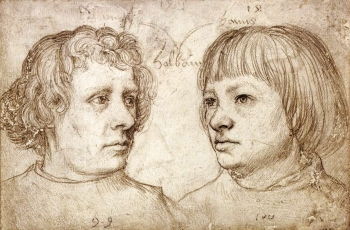
Hans Holbein the Younger was born in the flourishing commercial center of Augsburg in Germany, where wealthy patrician families encouraged artistic and intellectual activity. He was the second son of Hans Holbein the Elder, one of the most renowned panel painters of the Late Gothic period, who specialized in both religious paintings and portraiture. A silverpoint portrait of the two brothers dated 1511 notes that Hans was 14 at the time, meaning that his date of birth was around the end of 1497 or early 1498. It is generally assumed that the elder Holbein trained both his sons as painters (Hans' brother Ambrosius also became one), however, many of Holbein's family were also artists including his uncle, Sigmund who was a painter and his grandfather who had been a goldsmith and it is possible that they, too, had an influence.
Early Training and Work
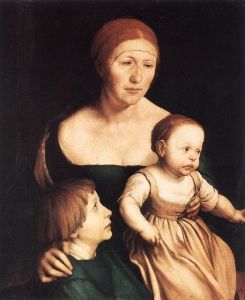
Both Holbein brothers left Augsburg and relocated to the city of Basel, around 1515, where they were apprenticed to Hans Herbster, the city's leading painter. Legal records show that the Holbein brothers were involved in a brawl in Basel in the Summer of 1516. The following year, records show that Holbein was again involved in a fracas, this time with a goldsmith, for which he was fined 5 livres for fighting in the street. It is thought that the artist then travelled to northern Italy for a period, to learn from Italian masters of fresco such as Andrea Mantegna. On his return to Basel, he quickly established himself in the city, running a busy workshop and joining a painters' guild. He also married Elsbeth Binzentock, a widow a few years older, who already had an infant son; they had a further four children together.
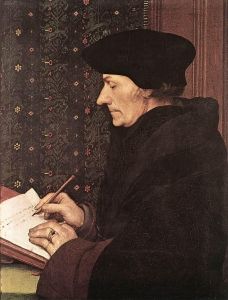
Between 1520 and 1524, Holbein's success in Basel grew with him producing murals, religious paintings, designs for stained glass and book illustrations. Yet despite this, it does not appear that he was particularly wealthy during this period, and he was only able to buy a house in 1528, after the success of his first residence in England. During this time, he was introduced to famous Dutch Humanist and theologian, Erasmus, and the two became well acquainted, with Holbein painting several portraits of him. Such portraits developed Holbein's reputation and when he travelled to England in 1526 the letters of recommendation from Erasmus, which he carried with him, secured his entry into well-connected circles, most notably that of Thomas More for whom he painted the famous portraits Portrait of Sir Thomas More (1527) and Thomas More and Family (c.1527).
This sober composition emphasizes Erasmus' focus on his writing. Although there is an intimate feeling from the closely cropped framing, there is also a sense of it being an official portrait with Erasmus' pose in profile referencing heraldic images.
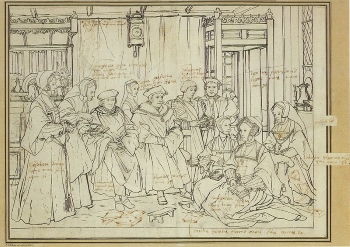
This preparatory sketch was completed during Holbein's first residence in England and it has been suggested that More sent it to Erasmus as a gift, following the Dutch scholar's recommendation of the artist.
Holbein returned to Basel in 1528 and stayed for four years, buying a second house in 1531. The city, however, had become politically and religiously unstable during his absence. Artistic imagery was banned from churches, being removed by reformers and either burnt or sold for firewood. The turbulent state of the city perhaps contributed to his motivation to reside elsewhere and he once again left for England with letters of recommendation from Erasmus.
Mature Period
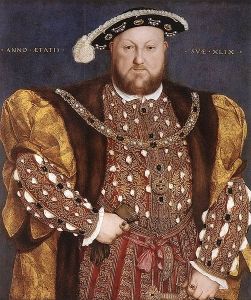
On returning to England, Holbein distanced himself from the Humanist circles that had employed him on his first trip as they had fallen out of favor with reigning monarch Henry VIII and, indeed, Sir Thomas More was executed in 1535. Instead Holbein found employment as a portrait painter for a number of wealthy Lutheran merchants. In 1533 they commissioned him to produce a street tableau of Mount Parnassus for the coronation procession of Anne Boleyn, Henry VIII's second wife and this may have opened the door for his employment in the royal household. Initially charged with designing jewelry for the new queen, he was soon after described by court poet Nicolas Bourbon as 'the King's Painter.' The artist also enjoyed the patronage of Thomas Cromwell. As lawyer, statesman, and chief minister to the King, Cromwell masterminded Henry VIII's public rehabilitation in the wake of scandal surrounding his many marriages and his decision to reform and lead the English church. For this purpose, Holbein was commissioned to produce grandiose images of propaganda displaying the power and righteousness of the king.
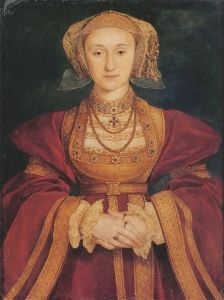
The accounts for the royal household from 1536 include Holbein as a court painter with a yearly income of £30 and his employment continued for some years. Holbein seems to have painted the king a number of times, but the only surviving painting is a half-length portrait in the collection of the Thyssen-Bornemisza Museum in Madrid. Amongst his other royal commissions, he was also tasked with capturing likenesses of potential brides for Henry. For one such commission he was sent to Duren with orders to produce a portrait of intended bride Anne of Cleves. Treading a careful path, he had to both satisfy the foreign officials and create a true-likeness from which Henry could make his decision to wed or not. Holbein's diplomacy in his rendering of Anne may have exacerbated Henry's displeasure at finding his new bride more like a 'fat flanders mare' when she arrived for the wedding ceremony in January 1540.
Late Period
The blame for Henry's disappointment at finding his wife's appearance so unattractive fell firmly on Thomas Cromwell, as he had encouraged the marriage and reportedly exaggerated her beauty. He was swiftly executed and Holbein found himself without a patron, marking the decline of his career as court painter. He returned to private commissions including merchants and other members of Henry's court. It is possible that Holbein briefly returned to Basel in 1540, when his leave of absence expired, but he was definitely in London when he died in 1543, at the age of 45, possibly from the plague, although this diagnosis has been disputed. The site of his grave is unknown.
Although he remained married to Elsbeth until his death, Holbein does not appear to have been a family man and their marriage was likely strained by his long absences and infrequent visits. His 1543 will revealed that he had two illegitimate infant children in England, left to the care of a nurse. In addition to this infidelity, it has been suggested that the model for his Darmstadt Madonna was also his mistress. Despite this, he supported his wife and children throughout his residences in England and when Elspeth died in 1549, she was living quite comfortably.
The Legacy of Hans Holbein the Younger
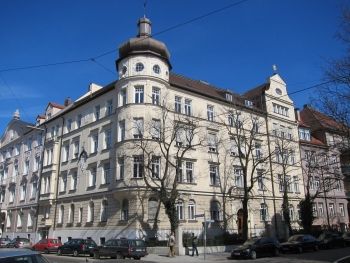
A street in the city centre of Munich was renamed Holbeinstraße in the artist's honor in 1899, illustrating his legacy, in Germany, as an artist of the Reformation. It is in England, however, that Holbein's legacy is most acutely evident. A combination of his prolific artistic output and the fame of the sitters cemented his reputation and shaped our visual notion of Tudor England. His portraits were so influential and so widely copied that many images of this period of English history can be seen to visually reference his works. There is no clearer example of this than his full-length portrait of Henry VIII. This famous image projected notion of health, wealth, power, and masculinity and was widely copied by contemporaries and successors, such as Hans Eworth and Regimus van Leemput, as well as many unknown artists. There is perhaps no other royal portrait which has so successfully captured, and even shaped our notion of the sitter. As a result of this, Holbein has gained a reputation for flattering his sitters and this has been celebrated and lampooned in popular culture, most recently in the West End musical Six, in the song Haus of Holbein.
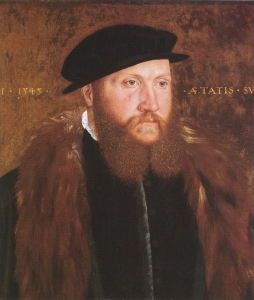
Holbein had no studio and as such, only seems to have had one direct imitator, John Bettes the elder. His mastery in painting, in capturing light and space, and his incorporation of personal objects into images, however, influenced 16th and 17th century portraitists including Nicholas Hilliard, Rembrandt, Jan Vermeer, van Dyck, and Rubens. Holbein had a resurgence in the late-19th century when he inspired a number of artists that advocated for greater naturalism in painting.
He has retained his popularity since, and his style and techniques can also be seen to extend to the present day, influencing modern artists such as Jane Egan in her work Holbein Hands (1992) which incorporated part of Holbein's portrait Christina of Denmark (1538). Looking at Tracey Emin's confessional self-portrait My Bed (1998), the personal artefacts revealing something about herself are reminiscent of the items and symbolism which filled Holbein's works. In the same vein portraits, such as Kehinde Wiley's 2018 depiction of Barack Obama, still reveal his artistic influence. Wiley endows the former president with both regal and human qualities, and the richly ornate background and attention to detail in the chair upon which Obama is seated also evokes his work.
Influences and Connections

-
![Jan van Eyck]() Jan van Eyck
Jan van Eyck -
![Titian]() Titian
Titian -
![Albrecht Dürer]() Albrecht Dürer
Albrecht Dürer - Hans Holbein the Elder
- Erasmus
- Thomas Cromwell
-
![Renaissance]() Renaissance
Renaissance -
![Northern Renaissance]() Northern Renaissance
Northern Renaissance -
![Mannerism]() Mannerism
Mannerism - Early Netherlandish
Useful Resources on Hans Holbein the Younger
- HolbeinBy Norbert Wolf
- Hans HolbeinBy Oskar Batschmann
- Hans Holbein: Portrait of an Unknown ManBy Derek Wilson
 Ask The Art Story AI
Ask The Art Story AI